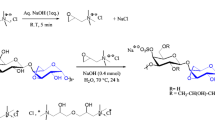Abstract
It has been established that hydrogen bonds control both gelation and helix formation completely in the case of agarose and partially in the case of kappa-carrageenan, the major role belonging in the latter case to the interactions of a polysaccharide with metal ions. Na+ and K+ ions form contact ion pairs with sulphate groups of kappa-carrageenan. It is supposed that an increase in the number of contact ion pairs together with association of macromolecules having unordered conformation, a decrease in the second virial coefficient, and a decrease in the refraction index increment (i.e., an increase in the solvation degree of dissolved particles) is a necessary condition for forming the kappa-carrageenan gel netwórk. A sufficient condition of kappa-carrageenan gelation is the intermolecular coordination binding of ions such as K+ ions, promoting gelation. The coil-to-helix transition of the polysaccharide is controlled by shielding the charge of kappa-carrageenan-sulphate groups. Hydrophobic interactions proved to be unessential for gelation of either agarose or kappa-carrageenan.
Similar content being viewed by others
References
Plashchina IG, Grinberg NV, Braudo EE, Tolstoguzov VB (1980) Coll Polym Sci 258:939–943
Plashchina IG, Muratalieva IR, Braudo EE, Tolstoguzov VB (1986) Carbohydr Polym 6:15–34
Braudo EE, Muratalieva IR, Plashchina IG, Tolstoguzov VB (1991) Carbohydr Polym 15:317–321
Muratalieva IR, Plashchina IG, Braudo EE, Tolstoguzov VB (1987) Izvestija Akademii Nauk Kirgizskoj SSR. Khimiko-tekhnologicheskije Nauki (in Russian) N 3:10–16
Morris VJ (1986) In Mitchell JR, Ledward DA (eds) Functinal properties of food macromolecules. Elsevier Applied Science, London, New York, pp 121–170
Mirsky AE, Pauling L (1936) Proc Natl Acad Sci USA 22:439–447
Jencks WP (1969) Catalysis in chemistry and enzymology. McGraw-Hill, New York, p 435
Izmaylova VN, Rebinder PA (1974) Strukturoobrazovanije v Belkovikh Sistemakh. Structure-formation in proteinaceous systems, in Russian. Nauka, Moscow, p 28
Morris VJ, Chilvers GR (1983) Carbohydr Polym 3:129–141
Semenova MG, Plashchina IG, Braudo EE, Tolstoguzov VB (1988) Carbohydr Polym 9:133–145
Watase M, Nishinari K (1982) Colloid Polym Sci 260:971–975
Watase M, Nishinari K (1982) Rheol Acta 21:318–326
Watase M, Nishinari K (1986) In: Phillips GO, Wedlock D, Williams P (eds) Gums and stabilizers for the food industry-3. Elsevier Science, Amsterdam, p 185
Kochetkov NA (ed) (1967) Metodi Khimii Uglevodov. Methods in carbohydrate chemistry, in Russian Mir Publ, Moscow, p 339
Usov AI, Yarockij SV, Shashkov AS (1978) Bioorgan Khim (in Russian) 4:745–751
Ferry JD (1948) Adv Protein Chem 4:1–78
Watase M, Arakawa K (1968) Nippon Kagaku Zasshi 89:383–387
Watase M, Nishinari K (1986) Food Hydrocoll 1:25–36
Grinberg NV, Plashchina IG, Braudo EE, Tolstoguzov VB (1980) Coll Polym Sci 258:1038–1043
Belton PS, Morris VJ, Tanner SF (1986) Macromolecules 19:1618–1621
Grasdalen H, Smidsrød O (1981) Macromolecules 14:229–231
Smidsrød O, Grasdalen H (1982) Carbohydr Polym 2:270–272
Belton PS, Morris VJ, Tanner SF (1985) Int J Biol Macromol 7:53–56
Rabinovitch E (1942) Rev Mod Phys 14:112–131
Orgel LE (1954) Quart Revs (London) 8:422–450
Platzman R, Franck J (1954) Z Phys 138:411–431
Smith M, Symons MCR (1958) Trans Faraday Soc 54:338–345
Mason SF (1961) Quart Revs (London) 15:287–391
Blandamer MJ, Gough TE, Symons MCR (1966) Trans Faraday Soc 62:286–295
Franck J, Kuhn H, Rollefson G (1927) Z Phys 43:155–163
v Halban H (1928) Z Elektrochemie 34:489–497
Fromherz H, Menschick W (1929) Z physik Chemie Abt B 3:1–40
Fromherz H, Menschick W (1930) Z physik Chemie Abt B 7:439–467
Yuryev VP, Braudo EE, Tolstoguzov VB (1983) Coll Polym Sci 261:210–214
Norton IT, Goodall DM, Morris ER, Rees DA (1983) J Chem Soc Faraday Trans I 79:2489–2500
Hiraoka M (1982) Crown compounds: their characteristics and applications. Kodansha, Elsevier, Amsterdam Oxford New York p 97
Mukerjee P, Mysels KJ, Kapauan P (1967) J Phys Chem 71:4166–4175
Gordon JE (1975) The organic chemistry of electrolyte solutions. Wiley-Intersci, New York, Ch. 3
Author information
Authors and Affiliations
Rights and permissions
About this article
Cite this article
Braudo, E.E., Muratalieva, I.R., Plashchina, I.G. et al. Studies on the mechanisms of gelation of kappa-carrageenan and agarose. Colloid Polym Sci 269, 1148–1156 (1991). https://doi.org/10.1007/BF00654123
Received:
Accepted:
Issue Date:
DOI: https://doi.org/10.1007/BF00654123




